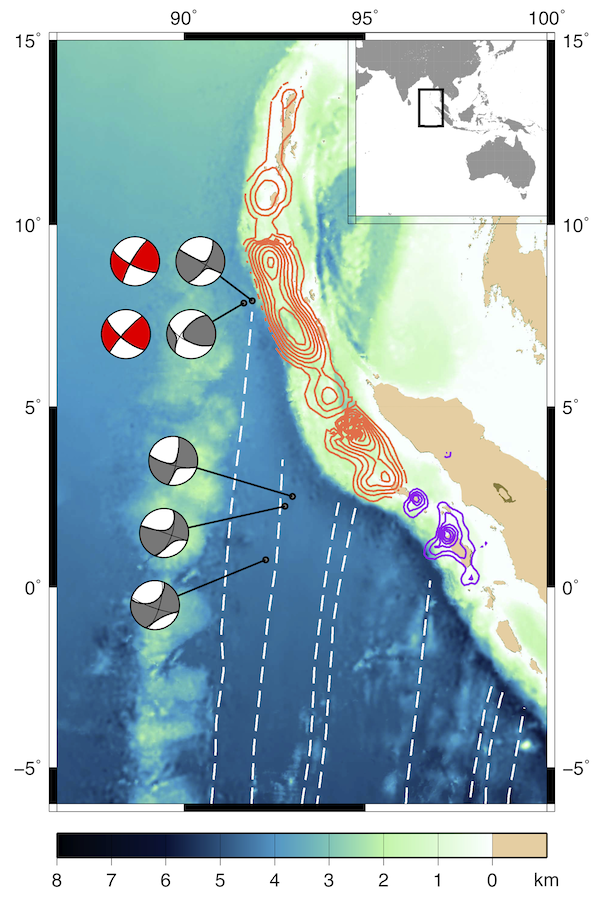2012 IRIS Workshop
Oceanic Strike-Slip Earthquakes Along the Sumatra Subduction Zone
Kasey Aderhold: Boston University, Rachel E. Abercrombie: Boston University
Bathymetric map of the Sumatra region with the first motion focal mechanisms (red) and the Global CMT solutions (grey) for strike-slip earthquakes of MW 䊫 7 since 2005, from north to south: 2005 MW 7.2, 2010 MW 7.5, 2012 MW 7.2, 2012 MW 8.6 and 2012 MW 8.2. The slip models of the 2004 MW 9.2 Sumatra-Andaman (orange) and the 2005 MW 8.5 (pink) are displayed in 2-meter slip contours (Chlieh et al., 2007; Konca et al., 2007). Fracture zones are shown as white dashed lines (Matthews et al., 2011).

Full-resolution graphics file in original format: 0118.jpg
The greater global coverage of broadband seismic stations provided by IRIS has allowed for the calculation of better-constrained moment tensors for all recent earthquakes, but particularly for oceanic strike-slip earthquakes that are often far from continental stations and have relatively small body-wave amplitudes. On April 11, 2012, the two largest strike-slip earthquakes recorded since at least 1950 occurred within two hours of one another in the shadow of the devastating 2004 Sumatra-Andaman tsunami earthquake. These two recent events join to make a group of five intraplate strike-slip earthquakes of magnitude greater than MW 7 that have occurred along the Sumatra subduction zone since 2005. We calculate the moment tensors for the 2005 MW 7.2 and the 2010 MW 7.5 earthquakes using both P and S teleseismic body-waves from 39 broad-band stations. The 2005 event appears to be a relatively simple strike-slip event with a centroid of ~25 kilometers. The 2010 event appears more complex with a strike-slip earthquake triggering a thrust earthquake of at least the same magnitude, probably on the nearby subduction interface. This multiple event source complexity is similar to the 2000 MW 7.9 Enggano earthquake that occurred to the south of Sumatra on the southeastern edge of the 1833 subduction earthquake rupture (Abercrombie et al., 2003). Finite fault slip inversions will be performed using these constrained focal mechanisms to identify rupture characteristics of intraplate earthquakes in oceanic lithosphere. Subducted fracture zones have been shown to influence the deformation of the overriding plate, therefore determining the source characteristics of these oceanic strike-slip earthquakes is essential for putting constraints on the accumulated strain of subduction zones and calculating the potential rupture extent of tsunamigenic earthquakes.
Acknoweldgements: This work is supported by the National Science Foundation through award OCE 0850503. We thank the IRIS DMC for providing access to the waveform data used in this study and the California Institute of Technology Tectonics Observatory for providing the slip distributions. The figure was made using the Generic Mapping Tools (Wessel and Smith, 1998).
Keywords: strike-slip_earthquakes, earthquake_source_parameters, broadband_body_waves
